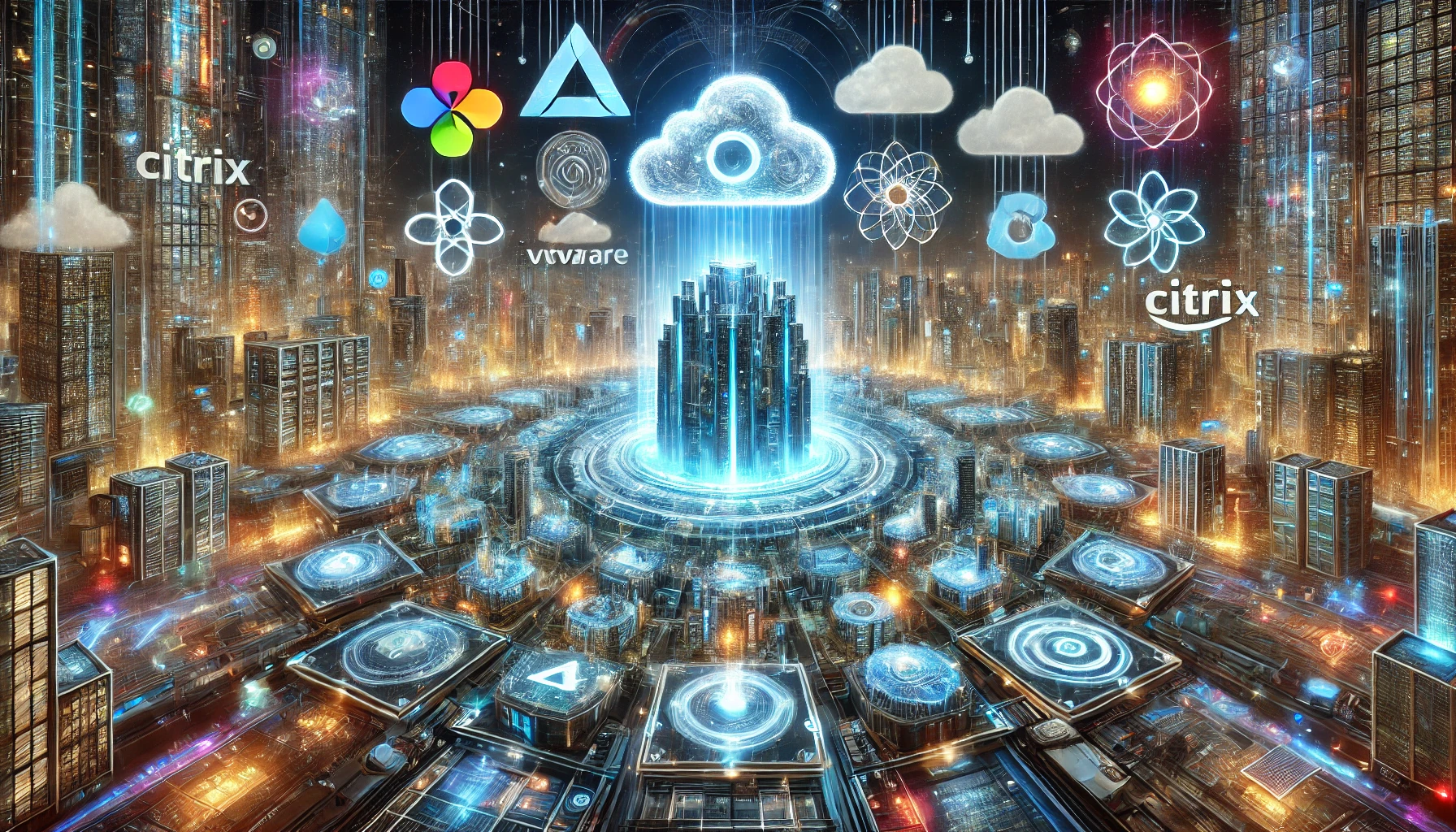In today’s rapidly evolving IT landscape, organizations face increasing complexity managing distributed workforces, diverse applications, and hybrid infrastructures. Amid this complexity, Citrix continues to evolve its virtualization and digital workspace solutions. But the question remains: Is Citrix still relevant in 2025, and how does it fit into an ecosystem dominated by VMware, cloud platforms, Azure, Proxmox, and Nutanix? This comprehensive analysis explores Citrix’s current positioning, its evolution, and its place in the modern enterprise IT stack.
The Evolution of Citrix in the Digital Workspace
Citrix has transformed significantly from its origins as a simple application virtualization solution. Today, it stands as a comprehensive digital workspace platform designed to deliver secure access to applications and data across any device, network, or cloud environment. This evolution reflects broader industry shifts toward hybrid work models and distributed IT infrastructures.
From Perpetual Licensing to Subscription Model
In October 2022, Citrix eliminated perpetual licensing and moved entirely to a SaaS subscription model for all its offerings. This strategic shift aligned Citrix with market standards and positioned the company for more consistent revenue streams and product development cycles1. While some customers with on-premises deployments initially preferred the one-time payment structure of perpetual licensing, the subscription model has enabled Citrix to deliver more frequent updates and innovations.
Core Citrix Offerings in 2025
Citrix’s product portfolio now centers around two primary deployment models:
Citrix Virtual Apps and Desktops provides application virtualization and VDI for organizations that want to self-manage their end-user computing infrastructure in corporate datacenters1.
Citrix DaaS (Desktop as a Service) delivers application and desktop virtualization as a service from any cloud or data center, offering greater flexibility for organizations embracing cloud-first strategies12.
For organizations still preferring the legacy self-managed approach, Citrix offers DaaS Advanced Plus at $13 per month, which serves as a replacement for the traditional Citrix Virtual Apps and Desktops1.
The Citrix Architecture: Cloud vs. On-Premises in 2025
Understanding Citrix’s architectural options is crucial for organizations evaluating its relevance in their technology stack.
Citrix Cloud: The Control Plane Evolution
Citrix Cloud centralizes the control plane (management, orchestration, licensing) in Citrix-managed data centers, while workloads can still run on-premises or in public clouds of choice. According to Forrester’s Total Economic Impact study, companies adopting Citrix Cloud can reduce operational overhead by up to 71%, primarily through automatic service updates and simplified management5.
Key Components Managed by Citrix in the Cloud Model:
- Delivery Controllers: Load balancing applications and desktops, authenticating users, and brokering connections directly from the cloud2
- Databases: Storing site configuration, monitoring, and configuration logging data2
- Licensing: Managing licenses and providing usage statistics2
- Studio: A web-based central console for configuration and management2
- Monitor: Enabling IT support teams to monitor environments and troubleshoot issues2
On-Premises Deployment: Still Viable in 2025?
Despite the cloud push, on-premises Citrix deployments remain relevant for specific use cases. Organizations in highly regulated industries—government, finance, and healthcare—often lean toward on-premises or hybrid deployments to address rigorous compliance mandates5.
The decision between cloud and on-premises is increasingly nuanced. IDC’s Worldwide Cloud 2025 Predictions suggest that over 70% of organizations will adopt a hybrid or multi-cloud approach for their VDI environments, citing needs for flexibility, workload optimization, and business continuity5.
Citrix in the Modern Multi-Vendor Ecosystem
The virtualization and cloud market has become increasingly competitive, with VMware holding a dominant 42.97% market share3. However, Citrix has carved out its niche by focusing on end-user computing and digital workspace solutions rather than competing directly with VMware’s broader virtualization portfolio.
Citrix and VMware: Competitors or Complementary?
While often viewed as direct competitors, Citrix and VMware can actually complement each other in many enterprise environments:
- VMware excels in server virtualization and broader infrastructure management
- Citrix specializes in application and desktop delivery with a focus on user experience
Many organizations use VMware for their underlying virtualization infrastructure while deploying Citrix for application and desktop delivery, leveraging the strengths of both platforms.
Citrix and Cloud Platforms (Azure, AWS, GCP)
Citrix has embraced cloud integration, positioning itself as an orchestration layer that works across major public cloud providers:
Citrix Cloud simplifies control-plane management across AWS, Microsoft Azure, and Google Cloud Platform, allowing IT teams to orchestrate resources globally with fewer administrative silos5.
Studio AWS Quick Deploy now supports adding non-BYOL-enabled AWS accounts, providing more flexibility in cloud deployments7.
This cloud-agnostic approach allows organizations to avoid vendor lock-in while still benefiting from cloud economics and scale.
The Technical Evolution: Citrix Features in 2025
Citrix continues to innovate across its product portfolio, with significant enhancements released throughout 2025.
Latest Innovations in Citrix Workspace App
Recent updates to Citrix Workspace app across platforms demonstrate Citrix’s commitment to improving user experience and performance:
For HTML5 and ChromeOS (2502 release):
- Improved in-session toolbar
- Connection strength indicator
- Service continuity (Technical Preview for HTML5)
- Support for horizontal scrolling on trackpad
- Session launch diagnostics
- Enhanced seamless app launch and resizing experience
- Support for Unified Communications SDK6
For iOS (25.1.4 release):
- Enhanced Citrix security with pre-populated username
- Support for GACS authenticated microservices (On-premises)
- Enhanced cross-multi screen experience
- DPI matching
- Default landscape orientation for virtual desktops
- Enhanced secured ICA6
Citrix DaaS and Virtual Apps and Desktops Enhancements
Citrix continues to expand platform support and management capabilities:
Support for Windows Server 2025: Citrix Virtual Apps and Desktops now fully supports Microsoft’s latest server operating system7.
Studio Improvements: Support for provisioning persistent VMs on Windows Server OS using Full Copy Clone, improving data recovery and migration capabilities while potentially reducing IOPS after machine creation7.
Backup and Restore: Now generally available, this feature enables creating on-demand and scheduled backups and restoring deleted applications, policies, and more7.
Security and Compliance in the Citrix Ecosystem
Security remains a critical consideration for organizations evaluating Citrix in 2025, particularly as zero-trust architectures become the standard.
Zero Trust and Advanced Security
Citrix has integrated zero-trust principles into its platform through offerings like Secure Private Access, which works with both on-premises and cloud deployments5. This approach is particularly valuable for industries with strict regulatory requirements.
The Citrix Application Delivery Controller (ADC) plays a crucial role in securing application delivery with features including:
- Web Application Firewall (WAF)
- SSL offloading
- DDoS protection
- Integrated security monitoring4
Compliance and Data Sovereignty
Data sovereignty requirements—such as the EU’s GDPR and industry-specific regulations—continue to influence deployment decisions. Citrix addresses these concerns through:
- Multiple global regions for Citrix Cloud
- Options for local control-plane hosting
- Hybrid deployment models that keep sensitive data on-premises while leveraging cloud management5
The Economic Equation: Citrix Pricing and TCO in 2025
The shift to subscription pricing has changed the economic calculations for Citrix deployments.
Subscription Pricing Structure
Citrix DaaS Advanced Plus is priced at $13 per month per user, in addition to the costs incurred for maintaining and managing infrastructure1. This subscription model provides predictable OpEx costs but requires careful long-term TCO analysis compared to depreciated on-premises infrastructure.
Cloud Economics vs. On-Premises Investment
The economic comparison between Citrix Cloud and on-premises deployments involves several factors:
Citrix Cloud advantages:
- Reduced administrative overhead through automatic updates
- Simplified licensing and billing
- Faster access to new features and innovations
- Ability to scale resources up or down based on actual usage5
On-premises considerations:
- Greater control over infrastructure and update cycles
- Potential long-term cost advantages for stable environments
- Ability to leverage existing infrastructure investments
- Reduced dependency on internet connectivity and cloud SLAs5
Citrix in Specific Industry Contexts
Citrix solutions continue to play crucial roles across various industries, with particular strengths in certain sectors.
Healthcare
In healthcare environments, Citrix enables secure access to electronic health records and clinical applications while maintaining HIPAA compliance. The ability to deliver applications to any device is particularly valuable in hospital settings where clinicians move between workstations and use various devices.
Financial Services
Financial institutions leverage Citrix for secure application delivery with strict access controls and monitoring. The centralized management and security features help maintain compliance with financial regulations while enabling flexible work arrangements.
Government and Public Sector
Government agencies often choose Citrix for its strong security posture and ability to support legacy applications. The option for on-premises or hybrid deployments addresses sovereignty and compliance requirements specific to government operations.
Citrix vs. Alternative Solutions in 2025
While Citrix maintains a strong position in the digital workspace market, several alternatives have gained traction.
Microsoft Windows Virtual Desktop/Azure Virtual Desktop
Microsoft’s native virtual desktop solution has become a strong competitor, particularly for Microsoft-centric organizations. The tight integration with Microsoft 365 and Azure provides advantages for organizations already invested in the Microsoft ecosystem.
VMware Horizon
VMware Horizon offers virtual desktop infrastructure with tight integration to VMware’s broader virtualization stack. Organizations heavily invested in VMware infrastructure may find Horizon a natural extension of their environment.
Nutanix Frame
Nutanix Frame provides desktop-as-a-service capabilities with a focus on simplicity and integration with Nutanix’s hyperconverged infrastructure. It represents a compelling alternative for organizations using Nutanix as their primary infrastructure platform3.
Proxmox VE
While primarily focused on server virtualization, Proxmox VE has gained popularity as an open-source alternative to commercial virtualization platforms. It offers a different approach to virtualization but typically requires more technical expertise to implement VDI solutions3.
The Future Trajectory: Where Citrix Is Heading
Citrix’s product vision and strategy for 2025 and beyond focus on addressing the increasing complexity of IT environments while maintaining flexibility and security.
AI and Machine Learning Integration
Citrix has signaled future integrations with AI/ML technologies to optimize resource allocation, detect anomalies, and recommend performance improvements in real-time5. These capabilities will become increasingly important as environments grow more complex.
Simplification Without Sacrificing Flexibility
The Citrix platform continues to evolve to support complex enterprise IT environments while providing simplicity and maintaining the flexibility to use any cloud or hypervisor8. This approach aligns with the needs of organizations managing hybrid and multi-cloud environments.
Enhanced Analytics and User Experience
Citrix is investing in improved analytics dashboards and user experience enhancements, with cloud customers typically gaining access to these updates weeks or months before on-premises versions5. This focus on user experience remains a key differentiator for Citrix.
Making the Decision: Is Citrix Right for Your Organization in 2025?
Determining whether Citrix remains relevant for your organization requires a thoughtful assessment of your specific needs and environment.
Key Considerations for Citrix Adoption
Existing Infrastructure: Organizations with significant investments in on-premises infrastructure may find Citrix’s hybrid capabilities particularly valuable.
Workforce Distribution: Companies with highly distributed workforces benefit from Citrix’s focus on delivering consistent experiences across locations and devices.
Application Portfolio: Organizations with complex application portfolios, including legacy applications, often find Citrix’s application virtualization capabilities essential.
Security Requirements: Enterprises with stringent security and compliance needs may value Citrix’s comprehensive security features and flexible deployment options.
Cloud Strategy: Your broader cloud strategy will influence whether Citrix Cloud aligns with your organizational direction or if an alternative approach makes more sense.
Conclusion: Citrix’s Place in the 2025 Technology Landscape
Citrix has successfully evolved from its origins as an application virtualization provider to a comprehensive digital workspace platform. In 2025, it remains relevant by embracing cloud delivery models while maintaining options for on-premises and hybrid deployments.
The shift to subscription pricing aligns Citrix with broader industry trends and provides a foundation for ongoing innovation. Recent feature enhancements across the Citrix portfolio demonstrate the company’s commitment to improving user experience, security, and management capabilities.
While facing competition from VMware, Microsoft, and emerging alternatives, Citrix maintains distinct advantages in specific use cases and industries. Its ability to work across cloud platforms provides flexibility in an increasingly multi-cloud world.
For organizations navigating complex IT environments with distributed workforces, Citrix continues to offer a compelling solution that balances security, flexibility, and user experience. The key to success with Citrix in 2025 lies in aligning its capabilities with your specific organizational needs and broader technology strategy.
As the IT landscape continues to evolve, Citrix’s focus on simplification without sacrificing flexibility positions it to remain a relevant player in the digital workspace market for years to come. Whether deployed in the cloud, on-premises, or in hybrid configurations, Citrix continues to enable secure, flexible work experiences in an increasingly distributed world.




